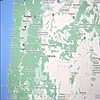HOME | DD
 AustinSPTD1996 — Bertie the Beaver
AustinSPTD1996 — Bertie the Beaver

Published: 2023-06-30 18:31:58 +0000 UTC; Views: 978; Favourites: 7; Downloads: 1
Redirect to original
Description
Be sure to read the description before commenting below.Hey guys, it's Austin. Do any of you recall my photo from earlier this month featuring those souvenirs I bought from my trip to Silver Falls State Park , including my new raven and beaver plushes? Well, in that picture I had hinted that I'd get around to posting pictures featuring each of those plushes individually, providing some insight into the animals they're based on.
While it may not be World Beaver Day, I decided to start by featuring my new American beaver plush -- Bertie. Bertie is named for hazelnut trees. Hazelnuts are the official state nut of Oregon and are also referred to as filberts by some people. Since the American beaver is the Oregon state mammal and our nickname is the Beaver State, I felt it was an ideal name for it. I have him sitting in the grasses near an area that, during winter, becomes a drainage ditch for rainwater. It was dry today so I felt it reasonable to take the toy out. If you don't mind, here's some information on American beavers -- courtesy of the Oregon Zoo, which owns a pair of the iconic rodents.
-----------------------------
American beavers (Castor canadensis) are found in streams, rivers, marshes, and small lakes throughout most of North America, from northern Mexico to western Canada. At a maximum of 60 pounds, they're the largest rodents in their range. A beaver's body is wonderfully adapted for swimming in cold water. The top layer of fur is waterproof, and its undercoat traps air and keeps its skin warm. The back feet are webbed for swimming, and the broad, flat tail provides steering and power. While it swims, a transparent membrane covers the beaver's eyes, and valves in its nostrils and ears keep water out.
These rodents build dams out of wood, grass, and mud to slow down the flow of water in streams and rivers. The dam creates an area of still water where they can build a lodge. The still water creates habitat for animals including waterfowl, fishes and frogs, making beavers a keystone species as well as ecosystem engineers. As I've recently learned on an Oregon Field Guide story, beavers' activities may also help to reduce wildfire risks . Effectively just a pile of sticks and mud, the lodge has an inner chamber that rises above the surface of the water. It has at least two underwater entrances. Beavers are secretive, going out at sundown, doing most of their activities at night, and returning to their dams at dawn.
Contrary to the popular misconception, beavers do not eat wood. Rather, when toppling trees for their dams, they're feeding on the soft, juicy and green inner bark of trees. They also feed on woody shrubs and the roots of tuberous aquatic plants. A beaver is capable of felling an 8-foot tree in five minutes flat. Like other rodents, a beaver's incisor teeth grow continuously throughout its life. Chewing on trees and other plants helps to keep their teeth worn down.
Beavers are often monogamous and live in family groups of at least six individuals, including parents, yearlings and kits. This group is known as a colony. Both parents play a role in rearing kits, providing food and protecting against predators. Adolescents live with their parents for up to 2 years, aiding the parents in infant care, food collection and dam construction.
Females have their first litter around 3 years of age. After a gestation period of 130 days (little over four months), she'll give birth to a litter of 2-4 babies, known as kits. Kits weigh between 0.5 and 1.5 pounds at birth and are born fully-furred with their eyes open. They can start swimming within 24 hours. After several days, the kits can dive out of the lodge with their parents to explore the surrounding area. They stay beside their parents until spring of the second year. In the wild, beavers can live into their mid-20s.
-----------------------------
American beaver conservation
Back in the 1800s, American beavers were frequently hunted and trapped for their fur. By the turn of the 20th century, they were nearly extinct through much of their original habitat. Pollution and habitat loss also affected their survival. In the last century, thanks to re-establishment programs and hunting regulations, beavers have made a successful comeback. They're now a species of least concern by the International Union for the Conservation of Nature. Current threats to beavers include habitat destruction, water pollution and hydroelectric dams.
One can help beavers by volunteering as a site steward. As a site steward, one can help keep their natural habitat healthy by volunteering to monitor wildlife, clear invasive species or plant native shrubs.


















